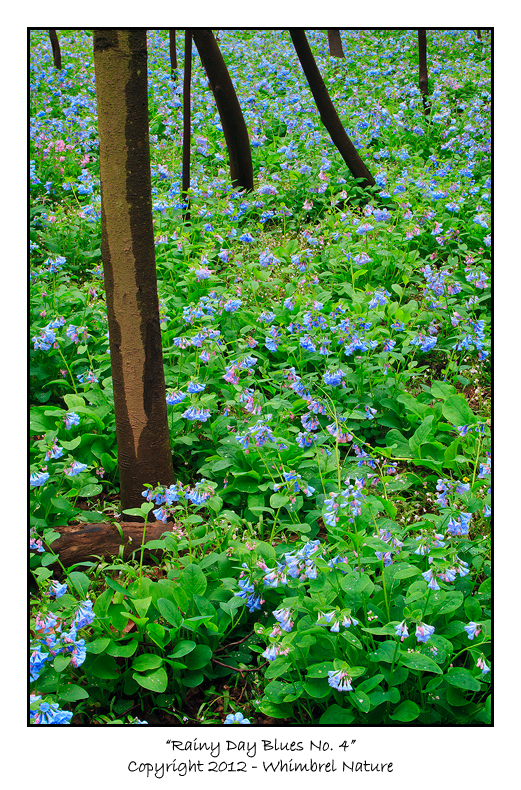03 April 2012
Don't Fear The Rain
Do you find yourself shutting off your alarm and rolling back over in bed when rain threatens? Or never setting the alarm in the first place? Well, as my mom was fond of saying when we were kids; "Are you made of sugar? You won't melt!"
When it comes to photographing early spring wildflowers, rain just might be your friend, rather than your enemy. Now, I'm not talking a steady downpour here. When that happens, it is difficult to work and the flowers are likely being buffeted by the raindrops, if not the wind. But if you are lucky enough to have a light drizzling rain, or passing showers with breaks in between, the conditions can be perfect for wildflower photography. First of all, many spring wildflowers are blooming under the forest canopy, and even before the leaves start coming out, when the sun is out, the wildflowers are bathed in a dappled mix of harsh light and dark shadow that falls beyond your camera sensor's ability to capture it. An overcast and rainy day, on the other hand, provides an even and diffuse light that is perfect for both macro and more wide-angle type work. Also when objects are wet, particularly leaves and tree trunks, the colors are saturated and vibrant. Finally, raindrops on the flowers and leaves can greatly add to the composition.
Obviously, there are some drawbacks to photographing in the rain. It can make it somewhat difficult or uncomfortable to work. Simple procedures, like changing lenses, become more tricky. Depending on the temperature you can experience fogging issues with your lenses. There is less light available for exposures, meaning things like depth-of-field or an arrant breeze can become critical. Overcast skies can become a washed-out white or completely uninteresting uniform gray. However, all these problems can be overcome, with the right gear, a little preparation, and/or good technique in the field.
Some tips for rainy day wildflower photography:
1. Keep your lenses pointed down towards the ground, use a lens hood if possible, and cover your lenses with a lens cap when not in use.
2. Bring a microfiber lens cloth for when you forget #1 or a stray gust or splashing drop gets water on the front of your lens.
3. Bring a small towel (or absorbent clothing) to wipe off the rain that collects on your camera body and lenses, or consider using a rain cover. Be vigilant here, most modern cameras can take quite a bit of moisture without any problem, but if your camera is really getting soaked, consider packing it up until the rain slacks off again.
4. Try to minimize lens changes, and when necessary, do them under proper cover.
5. Bring an umbrella to use as a shelter for lens/battery changes or to cover your set-up during brief showers. But be aware that it is completely impractical to hold the umbrella while you are actually photographing (see #6).
6. Dress properly. Have a good raincoat with a hood, and consider wearing rain pants or at least quick-dry nylon pants. If you stay dry and warm, you are more likely to enjoy yourself, and you are more likely to take the time to get good compositions and wait out any breezes. You are also more likely to get down on the ground to get those low angle shots.
7. Unless you have some dramatic dark thunderstorm clouds to work with, plan to avoid including the sky in your compositions. Even if you expose properly or use an HDR technique, all you are likely to get is a boring featureless gray sky.
8. Be patient. Wait out those breezes or figure out how to block them. Worse case scenario, find another subject that is less exposed or consider doing motion abstracts.
9. Despite the lack of sun, still consider using a polarizer to remove reflections from the vegetation and help further saturate the colors.
10. I feel like this one should go without saying, but I'm always surprised. Use a tripod, even if your lenses have stabilization.
Photographing wildflowers in the rain can be quite rewarding and maximize your spring field time, despite the challenges. So get out there and do it!
Oh, one other benefit of photographing in the rain. You might have even the best spots to yourself. All the photographs on this page were taken on a rainy Saturday afternoon during peak bluebell season at Bull Run Regional Park near Manassas, VA. Normally on a peak weekend afternoon the place would be crawling with photographers, hikers, and tourists. On this afternoon, I saw one small family out hiking, and that was it. I had to wait out several passing showers and the inevitable breezes, but I think the results and the experience were worth the effort. Don't you?
Labels:
Tips and Locations
Subscribe to:
Post Comments (Atom)






Wonderful photos - and great tips. Particularly like Rainy day Blues # 3
ReplyDeleteGreat post, Elijah!
ReplyDeleteWonderful images and information Elijah, the colors are awesome
ReplyDeleteGreat Shots with really nice colors. My problem is waiting for a rainy day! Skies this time of year are cloudless masses of blue with 9% humidity. The one day it did rain it came with 30 MPH winds.
ReplyDeleteI tend to stay indoors with my camera on a rainy day. This wonderful post makes me wish for a day of drizzle. Great rainy day photography tips! Gorgeous, rich photographs!
ReplyDelete